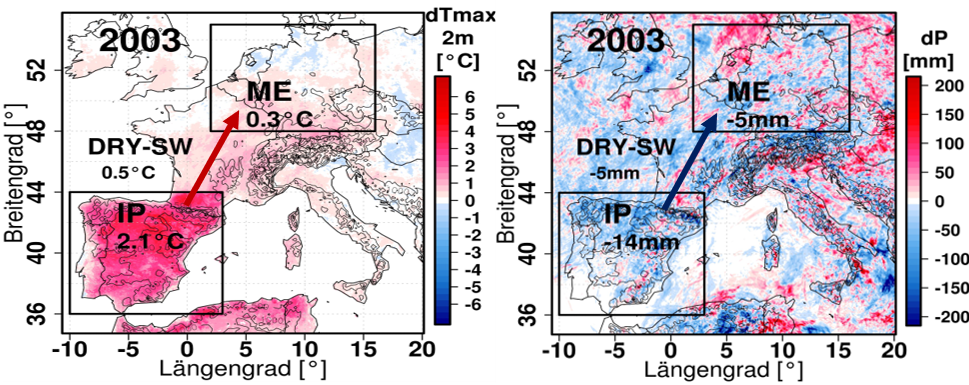Contribution of Mediterranean soil moisture conditions to heat wave intensity in Central Europe
European heat waves, such as those in summer 2003 and 2015, have a high heat-related mortality rate, e.g. 2003: 70,000 deaths, additionally causing important economic damages (e.g. 2003: 14 billion $, Munich Re, 2019). Moreover, during extreme heat periods the levels of ozone and other pollutants in the air raise exacerbating cardiovascular and respiratory diseases. Pollen and other aeroallergen levels are also higher in these periods. These can trigger asthma, which affects around 300 million people around the world.
Figure 1: Seasonal mean of maximum 2 m temperature, Tmax 2m (left) and precipitation, P (right) over the period June-July-August 2003, as a difference between the reference run and the initial dry soil sensitivity experiment (DRY-SW).
To reduce potential risks and damages improved understanding of the mechanisms that lead to the occurrence of extreme phenomena is needed. A contributor to the severity of summer heat waves in Europe is the soil moisture conditions in spring and previous winter precipitation in the south-western Mediterranean (SWMed) region. In this study, we investigate the relationship and impact on atmospheric processes of the SWMed soil conditions in spring and summer extreme heat in Central Europe. For this purpose, high-resolution seasonal simulations using the convection-permitting COSMO-CLM model (~3 km) are performed, in which dry and wet soil moisture initialization is applied and results compared with a reference experiment for the period June to August of 2003. For our sensitivity experiments the initial soil moisture scenario in late spring is modified depending on model soil definitions. Only the south-western area is dried/moistened to assess the impact on continental Europe.
The maximum impact affects locally the Iberian Peninsula with Tmax 2m temperature increases up to +6 °C when dry initial conditions are considered (Figure 1). The local air becomes too dry to yield rainfall, which further enhances drought conditions. A remote impact on Tmax 2m and precipitation are assessed. The Tmax 2m in Central Europe increases locally and a precipitation reduction is also seen, further contributing to the dryness of the area. Regarding the number of hot days (>30 °C) for the summer period, an increase of about +30 % demonstrates the relevant contribution of dry soil conditions in the WMed region preceding and contributing to the development of extreme heat in continental Europe.
Munich RE NatCatSERVICE, 2019: Heatwave / wildfire events worldwide 2003. URL https://natcatservice.munichre.com, visited on 11.04.2019.
For further information to this topic, please contact our Junior Investigator Group: Extreme Weather in a Changing Climate: http://www.imk-tro.kit.edu/6760.php
[Working Group: Junior Investigator Group: Extreme Weather in a Changing Climate]

